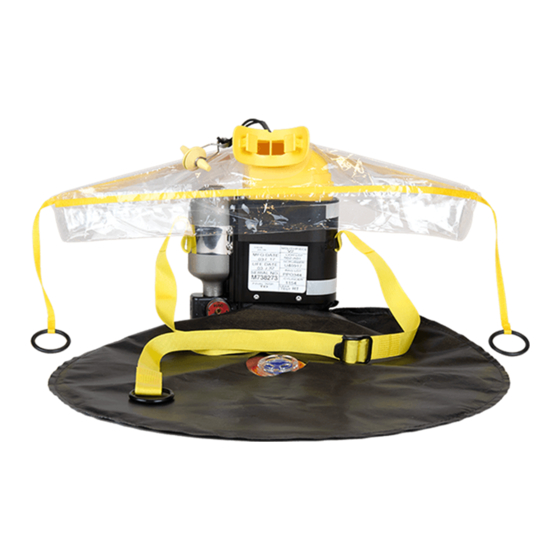
OCENCO M-20.2 Instructor's Manual
Emergency escape breathing device
Hide thumbs
Also See for M-20.2:
- Instruction manual (16 pages) ,
- Instruction booklet (48 pages) ,
- Instruction booklet (8 pages)
Table of Contents
Advertisement
Quick Links
Advertisement
Table of Contents

Summary of Contents for OCENCO M-20.2
- Page 1 Instructor’s Manual M-20.2 EEBD & M-20.2T Training Model Manual / Part No: 340021 Revision A, ECN 2368 July 30, 2001 Ocenco Incorporated 10225 82 Avenue Pleasant Prairie, Wisconsin 53158-5801 Phone: 262-947-9000 Fax: 262-947-9020 www.ocenco-eebd.com Page 1 of 14...
-
Page 2: Table Of Contents
2.1. How the M-20.2 EEBD Works................3 2.2. How to Don the M-20.2 EEBD................6 2.3. How To Inspect the M-20.2 EEBD................. 6 2.4. How to Care for the M-20.2 EEBD ................ 7 2.5. When to Don the M-20.2 EEBD................8 2.6. Specifications......................8 2.6.1. -
Page 3: Introduction
Ocenco M-20.2 EEBD. An M-20.2T training model is available for practicing the opening, and donning of the M-20.2 EEBD. The Ocenco M-20.2 EEBD can be belt worn or stored in a wall bracket. The Ocenco M-20.2 EEBD is a self-contained, compressed oxygen, emergency escape breathing device (EEBD). The Ocenco M-20.2 EEBD instantly provides breathable air, independent of the surrounding atmosphere, to a person escaping from toxic gas or an oxygen deficient atmosphere. - Page 4 (12) Cover - may have optional overcase pads, a user replaceable item that provides increased abrasion and impact resistance. (13) Base - if belt worn, the base stays on the belt after the M-20.2 EEBD has been removed from the case. The base has an overcase pad that provides increased abrasion and impact resistance.
- Page 5 9 & 16 Page 5 of 14...
-
Page 6: How To Don The M-20.2 Eebd
If the surrounding air temperature is above 38º C (100°F), and the needle is in the red zone, above the green zone, allow the M-20.2 EEBD to cool down to 18º - 24º C (64° - 75°F) for 24 hours. If the needle returns to the green zone, keep the M-20.2 EEBD in service. If the needle does not return to the green zone, remove the M-20.2 EEBD from service. -
Page 7: How To Care For The M-20.2 Eebd
Belt loops broken Missing tamper indicating ball If the M-20.2 EEBD fails any of the above inspections, or if at any time during its life the pressure gauge is out of the green zone, it should be removed from service. -
Page 8: When To Don The M-20.2 Eebd
(8) Interruption of air flow (9) Someone around you has difficulty breathing or passes out (10) Accidental release of hazardous material In the event of an emergency, always don your M-20.2 EEBD before attempting to escape or help others. 2.6. Specifications 2.6.1. -
Page 9: Dimensions
Secondary Container and then placed in a rigid bracket securely fastened to a wall or other substantial structure and, (4) if worn, the M-20.2 EEBD must be belt worn on the person for no more than one shift per day. -
Page 10: M-20.2T Training Model
(1) Cover - The M-20.2T Cover is similar in appearance to the M-20.2 EEBD Cover. (2) Base - The M-20.2T Base is similar in appearance to the M-20.2 EEBD Base. A “Caution For Training Use Only” label is on the front of the M-20.2T Base. - Page 11 Page 11 of 14...
-
Page 12: Theory Of Operation
(1) The M-20.2T is worn on the belt to demonstrate the proper orientation on the belt or placed in the blue Secondary Container to simulate the stored position. (2) The Latch Assembly is identical to the M-20.2 EEBD, so that the opening of the M-20.2T is practiced “hands on”. -
Page 13: Training Session Summary
(2) When should a person don the M-20.2 EEBD? The EEBD should be put on at the first indication of fire, explosion or suspected oxygen deficiency, when you feel faint or a person near you faints. -
Page 14: Effects Of Oxygen Deficiency
5.1. Effects of Oxygen Deficiency Oxygen is odorless, colorless and tasteless, so it’s presence or absence is impossible to detect with the senses. However, when the air you breathe is deficient in oxygen, some of the physiological effects you may experience can give you clues that you are in an oxygen deficient atmosphere. People breathing air that has as little as 13% to 17% oxygen usually become dizzy, notice buzzing in their ears, can have a rapid heart rate, and often suffer headaches.



Need help?
Do you have a question about the M-20.2 and is the answer not in the manual?
Questions and answers